A Hawaiian Renaissance That Could Save the World
By Sam 'Ohu Gon, Kawika Winter
This archipelago’s society before Western contact developed a large, self-sufficient population, yet imposed a remarkably small ecological footprint.
This archipelago’s society before Western contact developed a large, self-sufficient population, yet imposed a remarkably small ecological footprint.

As an undergraduate majoring in zoology at the University of Hawaiʻi in the late 1970s, one of us (Gon) approached the zoology department with the proposal that his two years of Hawaiian language fulfill the language requirement for his degree.
The department at the time initially rejected the idea, because the language was not part of their curriculum, and it took voices of support from professors in the department to reverse that decision. One argued, “Sam will go away for graduate training, and will return to Hawaiʻi to pursue a career in conservation. His training in Hawaiian language will surely be relevant to his work.”
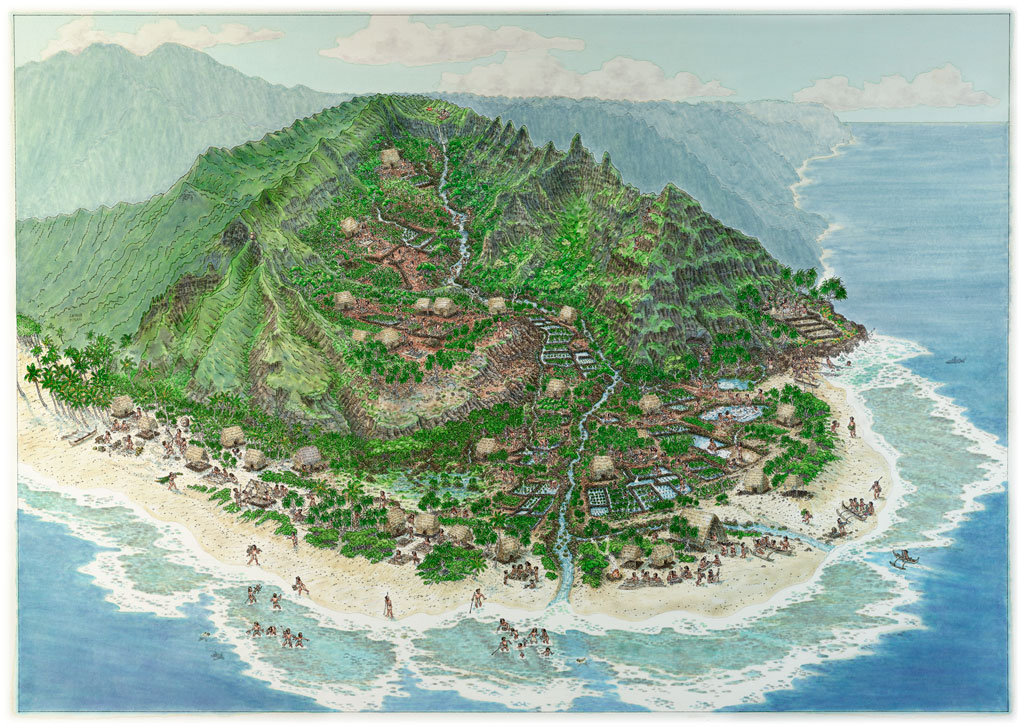
National Tropical Botanical Garden
That statement would prove prophetic, because we eventually teamed up with a small, growing group of Hawaiian scholars to look not just at Hawaiʻi as it is today, but also its past practices and how they are relevant to present challenges. Because of the traditional ecological knowledge held in Hawaiian language archives, we were not limited to the observations from the earliest Western naturalists forward, but from 1,000 years earlier. These archives, which noted historian Noelani Arista of the University of Hawaiʻi at Mānoa and we conclude is the largest single indigenous-language written archive in the world, became essential to our exploration of the history of landscape change in Hawaiʻi.
Through a combination of agricultural modeling, archaeological databases, modern ecological reconstruction techniques, global agroeconomic data, and that huge archive of traditional Hawaiian ecological descriptions predating first Western contact, we were able to follow the landscape history of Hawaiʻi back to the times before humans. We learned that, as in almost all places where people live, the Hawaiʻi of 1,000 years ago bears almost no resemblance to what we see today. We also uncovered findings about traditional Hawaiian lifestyle, such as how to sustain a population comparable to today while maintaining a majority of the landscape as forest and retaining all the ecosystem services that the forest provides. Such revelations may provide a pathway to a future of global sustainability for the planet—all thanks to a Hawaiian cultural renaissance that began in the 1970s and continues today.
After more than a century and a half of investigation by biologists, the world knows that the Hawaiian Islands are an archipelago of wonders, a showcase of coevolution. Huge ecological diversity provided the potential for unique life forms to emerge in the most isolated high island archipelago on Earth. This distinction recognized the Hawaiian Islands as a unique global ecoregion and a hotspot for biodiversity conservation. From an evolutionary profusion of birds that eclipses the Galápagos finches, to an endemic genus of snails that beautifully demonstrates how species can evolve when isolated only by adjacent ridges and valleys on a single island, the Hawaiian Islands not only showed how much can be generated by evolution, but also how vulnerable such small-scale diversification can be.
At the turn of the millennium, one of us (Gon) led a project for the Nature Conservancy of Hawaiʻi and its conservation partners in federal, state, and private organizations, mapping the distribution of broad terrestrial ecosystems representing native vegetation prior to human presence, alongside a mapping of the remaining native ecosystem footprint at the turn of the current millennium.
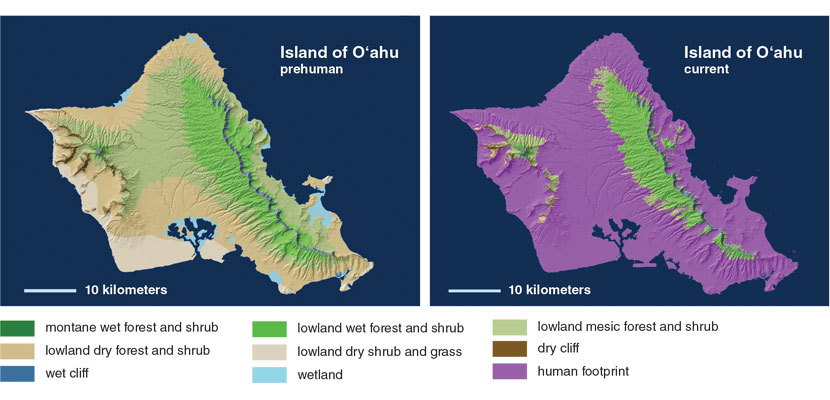
Adapted from Gon et al., 2018;The Nature Conservancy, Hawai‘i Program
It was a grim representation of massive loss that was so shocking that it made the front page of the newspapers at the time. On the island of Oʻahu, for example, fully 85 percent of the land that once was home to a diverse endemic set of ecosystems and species had been entirely lost, leaving small remnants only on the highest summit crests of the island (see the map above). This map graphically pointed out how burgeoning human presence in a limited island landscape had erased so much of the endemic biodiversity of the world’s most remote ecoregion in a few short centuries. Even with this loss, Hawaiʻi remains one of the most diverse places on the planet and offers a treasure trove of biological insights. Understanding the history of those losses and what remains is essential to charting a pathway forward.
One of the reasons that Hawaiʻi stands out as a model for exploring global trends and issues is that the archipelago is arguably home to the single richest set of ecological conditions on the planet. In Hawaiʻi you can go from geologically fresh, uncarved gentle slopes to the highest sea cliffs in the world; from lands that were created just this morning—barren and devoid of life—to climax forest supporting thousands of species; from volcanic cinder landscapes as dry as any of the world’s deserts to arguably the wettest spot on Earth; from coastal dunes at sea level to snow-capped summits just over 4,200 meters in elevation.
An analysis by the U.S. Forest Service mapped no less than 27 life zones in the Hawaiian Islands, out of 38 in the Holdridge life zones system, one of the classic ways to categorize global ecosystem diversity. This analysis prompted Jack Ewel, at the time a forester at the U.S. Forest Service, to remark to Gon that it made the Hawaiian Islands the single most ecosystem-rich location on the planet. Taken another way, if you had to choose one location on Earth to represent the full range of the planet’s ecosystems, it would be Hawaiʻi.
Hawaiʻi is also a microcosm because we can view the consequences of human history—including our positive and negative effects on nature—on compressed scales, both spatially and temporally. A range of Hawaiian ecological diversity exists on islands comprising less than 17,000 square kilometers and in some of the smallest functional watersheds on the planet (extending less than 10 kilometers inland as opposed to 100 kilometers or even more than 1,000 kilometers from source to mouth in continental settings). And on the temporal scale, the entire history of post-Pleistocene humanity in Hawaiʻi occurred on an extremely accelerated timeline—in a single millennium as opposed to 11.5 millennia in continental cases.
Although 20th-century interpretations of human history and humanity’s effects on ecosystems have been slanted almost entirely toward the negative—bearing an inherent bias that humans are intrinsically destructive of nature—modern research, including our work in assessing the human footprint of precontact Hawaiʻi and the land management of those times, has altered our view of humanity’s engagement with nature. This work results in a more nuanced understanding of the history of humanity’s footprint on our planet, one that included eras when people and nature coevolved and thrived together, as well as more recent phases when humanity’s commodification of nature has resulted in drastically increased rates of habitat degradation and loss, and extinction.
Human presence has been equated to habitat loss and extinction, but Homo sapiens is not always the primary cause of these calamities, and the humans who arrive first in a place are not always the catalyst for nature’s destruction. For example, voyaging Polynesians were the first to discover Hawaiʻi, the most remote landmass on the face of the planet, about 1,000 years ago. Rats (Rattus exulans), likely stowaways on the voyaging canoes, exploded in population size once they got to Hawaiʻi. Paleobotanical evidence suggests their ravenous consumption of large-seeded species—which once dominated Hawaiian forests—induced an ecological shift toward a forest dominated by smaller-seeded species. This regime shift resulted in a series of cascading extinctions that swept land crabs, land snails, and flightless land birds out of existence. Similar scenarios of rat-induced collapse of Rapanui’s (Easter Island’s) palm forests also challenge the idea of blind human abuse as the primary cause of that island’s socioecological demise.
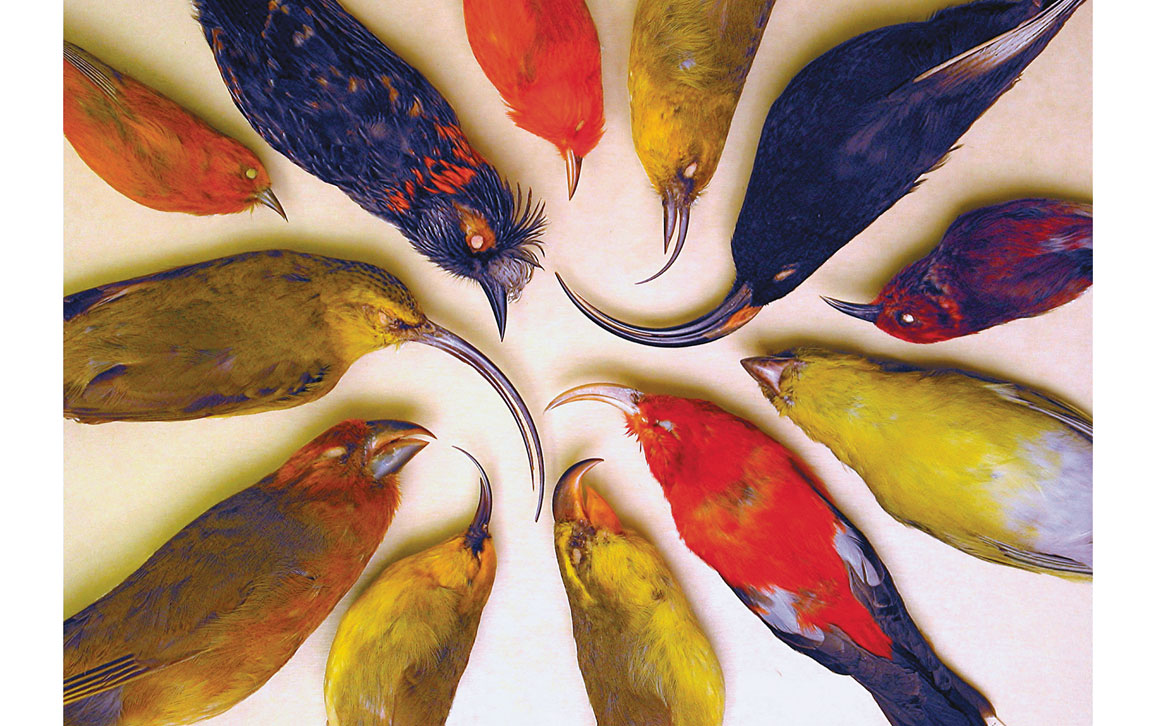
Photo by Carla Kishinami. Image courtesy of Bernice Pauahi Bishop Museum
By the end of the first millennium of human occupation here, Native Hawaiian society—through their resource management strategies—coevolved with the landscape and engineered a social-ecological system that maximized ecosystem services and the abundance of key resource species. They not only recognized the value of forests in producing ecosystem services, but also honored its intrinsic value and associated biodiversity. The oral traditions of Hawaiʻi are replete with reference to the biological diversity that distinguishes notable localities. One classic example is a chant dedicated to the elite warriors of King Kamehameha I from the late 18th century, one that describes notable plants of the ecosystems of his home district of Kohala, Hawaiʻi, in the forests of Waikā:
Kū akula ʻoe i ka mālānai a ke Kīpuʻupuʻu
Nolu ka maka o ka ʻōhāwai a Uli
Niniau ʻeha ka pua o koaiʻe
ʻEha i ke anu ka nahele o Waikā
Aloha Waikā i aʻu me he ipo la
Me he ipo la, ka maka lena o ke koʻolau...
You stand in the gentle breeze and the Kīpuʻupuʻu rain
Yielding is the bud of the ʻōhāwai (Clermontia sp.) of Uli
Bruised and injured is the flower of the koaiʻe (Acacia koaia)
Hurting in the cold in the forest of Waikā
Waikā forest loves me like a paramour
Like a lover’s eyes are the yellow buds of the koʻolau (Bidens sp.)
(This and all later translations are by the authors.)
The above chant was adapted into a popular song, called "Waikā," sung in this version by the Brothers Cazimero. (Courtesy of Mountain Apple Company, used with permission.)
Although the lowland forests of the Kohala Mountains have largely been destroyed, steep narrow gulches are refugia for plants that undoubtedly occupied the surrounding pasture-converted lands, and in those gulches are every one of the plants mentioned in that chant. Other ancient chants likewise provide specific descriptions of the flora and fauna of their landscapes, a few that still hold some of those named elements of precontact biocultural diversity, but more often they describe lost worlds for which there is no vestige remaining today.
Although writing was introduced to Hawaiians by American missionaries for the express purpose of rendering the Bible into their language, Hawaiians did not stop there. They recognized the archival value of writing, and a huge body of oral traditions were converted into written form. By 1850 the Hawaiian Kingdom, with a 90-percent literacy rate and more than 100 regularly published Hawaiian-language newspapers, was the most literate country on Earth. Those written sources provide us with an intimate look into both the worldview and the practical details of precontact Hawaiʻi, because, partly in response to the huge loss of traditional knowledge via foreign epidemics, Hawaiians of the 1800s responded by writing down knowledge that was previously only orally transmitted.
Those sources not only provided windows into the landscapes of the past, but also indicated that Hawaiians managed agroforests that integrated both native and crop species. For example, an intensively managed flooded terrace system for simultaneous cultivation of taro, fish, and waterfowl might be partially shaded and cooled by native forest canopies to all sides, and the water sources of those terraces maintained their endemic riparian vegetation, only partially augmented by those crops that optimally grew under those conditions. At least one of these crops, olonā (Touchardia sp., an endemic nettle), provided what still is regarded as one of the strongest plant-derived cordages known on Earth. It could not be grown in planted fields, but only along riparian corridors shaded by native forest. Thus, as intensively cultivated as Hawaiian fields were, they maintained strong native components, and any fallow fields rapidly converted back to native vegetation.
In addition, there were large tracts of “sacred forests” that were permanently left alone as refugia of endemic biodiversity and as essential watersheds. The sacred nature of forests points to an acknowledgement of native species of land and sea as ancestral to people, an ancient worldview held across Oceania. This relationship is made explicitly clear in the Kumulipo, a Hawaiian creation chant thousands of lines long that some have pointed to as evidence of the perceived concept of evolution and diversification of living forms out of related ancestors. Gon’s exploration of the Kumulipo and many other ancient chants points to the consequence of that familial, respectful reciprocal relationship that Hawaiians had with their environment. This work also reveals how this relationship is expressed in the Hawaiian footprint in the precontact era, where less than 15 percent of terrestrial ecosystems were used for intensified agriculture and habitation, and yet supported at least several hundreds of thousands of permanent human residents, completely self-sufficiently. This respect is also reflected in traditional sayings that confer prominence and superiority to the natural world in people’s relationship with nature. The classic example is “He aliʻi ka ʻāina, he kauā wale ke kanaka.” (The land is the ruler, the people merely servants.) According to a 2019 study in Nature Sustainability by Natalie Kurashima of the University of Hawaiʻi at Mānoa, the resource management strategies they employed included designing food systems that could sustainably feed over a million people with no external inputs, a population comparable to today.
The Hawaiian socioecological system recognized biogeographic patterns, noting that different living elements are to be found from summit to coast and that they extend from nearshore to reef to the edge of the pelagic. Thus, land-sea geographic units called ahupuaʻa were delineated to include these zones (see figure below), and adjacent ahupuaʻa together collectively comprised moku (districts). There might be five or more moku on a larger island, whereas a small island, such as Kahoʻolawe, the smallest of the eight main islands of the Hawaiian archipelago, might be a disjunct ahupuaʻa of a larger neighboring island’s moku. Each ahupuaʻa and each moku was served by a chiefly resource manager called a konohiki, trained from childhood to observe and assess levels of resources and authorized to impose and lift restrictions on their use—all toward the end of long-term health of the environment and in turn the well-being of people living within its bounds.
This conscious expert management of the land and people into largely self-sufficient units has been described as “ahupuaʻa management” and more recently refined as the Moku System by one of us (Winter) and his coauthors in the journal Sustainability. This system reduced resource conflicts between neighboring units, encouraged resource exchange between ahupuaʻa noted for particular resources, and created a network of land-management experts who coordinated their knowledge and actions with one another. This arrangement of ahupuaʻa and moku land units made so much inherent sense that they persist today in land ownership boundaries and island district boundaries in Hawaiʻi.
The Hawai‘i of 1,000 years ago bears almost no resemblance to what we find today.
For the better part of a millennium, this system resulted in a rich Polynesian society that practiced intensive land use, yet maintained a remarkably small ecological footprint that was often semiwild, encouraging native ecological system processes and services to continue supporting intensively managed terrestrial and nearshore farming systems to maintain a large human population. So when the first naturalists arrived in Hawaiʻi they documented a rich assemblage of endemic plant and animal life, as well as a vibrant human society.

Barbara Aulicino
The bounty of the sea provided most of the protein in fish, shellfish, shrimp, crab, and lobster, augmented by carefully introduced domesticated food animals, including pigs, dogs, and chickens, while both flooded-field and rainfed agriculture provided a cornucopia of vegetable foods: taro, sweet potato, bananas, breadfruit, yams, arrowroot, and others. Nearshore edible algal diversity provided vital minerals and other nutrients. It was a land of abundance—ʻaina momona was the traditional description, meaning “fat lands”! It was the skillful, intensive use of land and sea resources that kept the Hawaiian footprint so small, hand in hand with a worldview that considered the wild uplands as the wao akua—the intensely sacred home of the ancestral gods that cared for all people—as long as the people in turn cared for them. It resulted in 100- percent self-sufficiency within a small, but intensively worked footprint.
Massive habitat losses and nearly all the recorded extinctions of Hawaiian endemic species did not occur until the 19th century, after the influence of foreign powers took root, as Hawaiʻi raced to find its place in the coalescing global economy. Foreign diseases decimated 90 percent of the indigenous population, leaving an empty landscape that seemed like a paradise of opportunity for the foreigners who replaced their absence. In this century, hundreds of thousands of acres of forest were cut for both export and as fuel for steam engines—both trains and ships. The deforested land was readily converted to cattle and sheep pastures and monocrop sugar and pineapple plantations—two continental approaches to agriculture that were imposed upon our island systems, which would ultimately prove to be ecologically catastrophic. The Hawaiian lowlands now hold only tiny, highly modified remnants bearing a sad echo of their original ecosystem structure and diversity.
As Hawaiian ecosystems disintegrated, so did Native Hawaiian society. By the end of the 19th century, the U.S. government overthrew the weakened Hawaiian monarchy and imprisoned Hawaiʻi’s last monarch, Queen Liliʻuokalani. They established a republic controlled by American businessmen, suppressed Hawaiian language and culture, and moved to make Hawaiʻi a vital, strategic Central Pacific U.S. Territory and, in 1959, a state.
This habitat destruction, along with an ever-expanding series of unchecked introductions of nonnative plants and animals with ecosystem-modifying consequences, was the two-step catalyst for Hawaiʻi’s current extinction crisis. The well-known combination of the introduction of mosquitoes in 1826 and the later introduction of disease-bearing songbirds allowed diseases such as malaria and pox to ravage our susceptible endemic forest birds. As the birds declined, those plants they coadapted with to pollinate and disperse disappeared. In turn, the processes that drove speciation suddenly were truncated, and coevolution became coextinction.
The loss of hundreds if not thousands of unique species of plants, birds, and insects—both described and undescribed—affords Hawaiʻi the sad distinction as the extinction capital of the world. Many of the species lost had barely been described by Western naturalists before they went extinct, and the manuscripts written in the Hawaiian language in the 19th century to document disappearing biodiversity and biocultural traditions include dozens of plant and bird names that have no known extant reference, indicating that there have certainly been other losses we will never know about.
One such example is the sad story of one of Hawaiʻi’s recent extinctions. Pollen in sediment cores around the archipelago revealed that one of the most common plants in Hawaiʻi at the time of the first humans’ arrival mysteriously disappeared in the pollen record prior to European arrival. The mystery was solved when in 1991 botanists discovered two individuals clinging to existence on a tiny, rat-free islet off Kahoʻolawe, which was used as target practice by the U.S. military for five decades. Those last wild individuals eventually died, and no one was ever able to determine its original Hawaiian name. To honor its place in Hawaiian history, its scientific name, Kanaloa kahoolawensis, is rooted in the Hawaiian language and worldview.
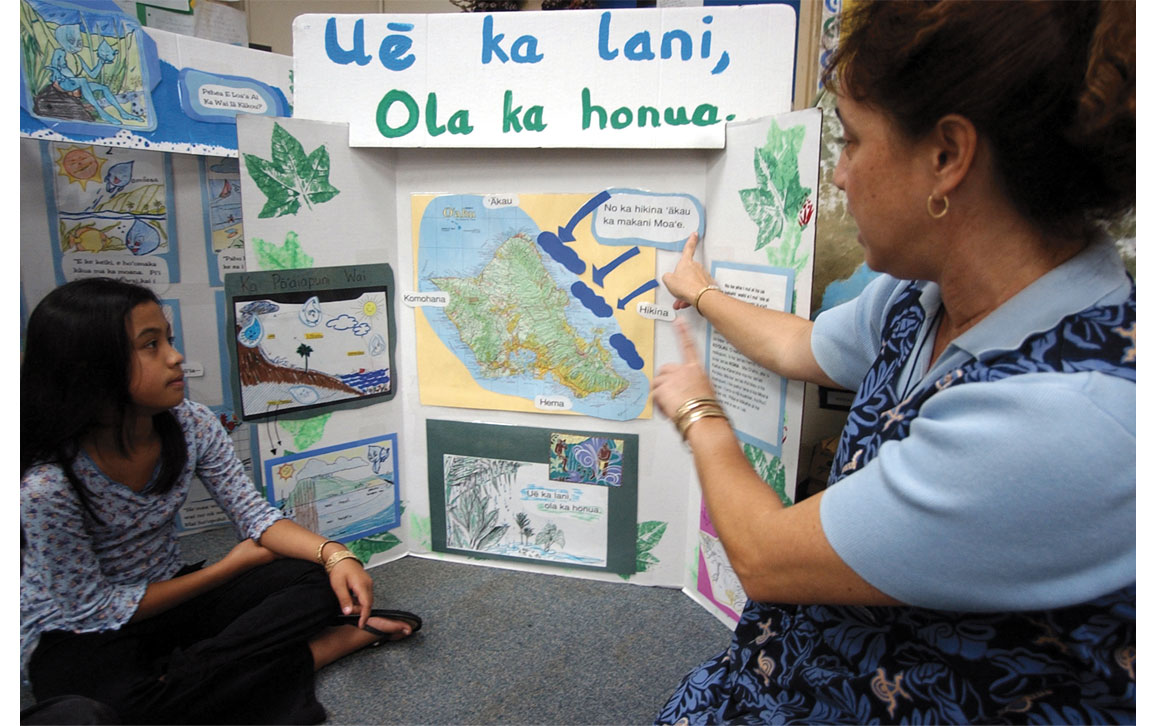
Lucy Pemoni/AP Images
Over the decades, only native Hawaiians and a handful of Western naturalists mourned these losses, although they tended to do so separately in the context of their worldviews. The Hawaiian culture itself—whose language and traditions are founded in the biodiversity of Hawaiʻi—did not escape this coextinction crisis, because with every species lost, their names could no longer be uttered except in the context of a lost past, and traditions centered on those species could no longer be practiced. The 20th century ushered in the modern era that swept up Hawaiʻi into the rest of the Western world. Wetlands were drained to develop Honolulu (including Waikīkī), and both agricultural lands and forests were destroyed to build suburbs to accommodate a post-statehood population explosion. By the end of the 20th century, Hawaiʻi’s population was again surpassing 1 million people, but now it depends on imports to provide 90 percent of its food and energy—the antithesis of sustainability.
It is in 21st-century efforts to regain sustainability and bolster socioecological resilience that Native Hawaiian biocultural approaches are emerging. But this renaissance itself might never have come about.
A large part of the groundswell of biocultural conservation and restoration efforts is the consequence of the Hawaiian cultural renaissance that began in the last half of the 20th century. It emerged as a new generation of Hawaiian singers embraced Hawaiian music. This musical resurgence was followed by renewed efforts to revive the Hawaiian language. At the time, it was predicted that Hawaiian would be a dead language by the year 2000. A few scholars of Hawaiian language combed the islands to interview and record the last, aging mānaleo (native speakers), and special schools were established that focused on teaching Hawaiian from infancy to adulthood. The 1896 law forbidding the teaching of Hawaiian in public schools was rescinded only in 1976, and by 1996, Hawaiian was once again listed as a state language.
On another front, in an ironic move ostensibly to celebrate the bicentennial of the United States in 1976, a goal was set to sail a double-hulled canoe of Hawaiian design, named Hōkūleʻa (Star of Gladness) from Hawaiʻi to Tahiti, over more than 2,500 miles of open ocean, using only traditional Polynesian navigation methods. It would require a rebirth of ethnoastronomy and a rebuilding of Hawaiian voyaging skills thought lost to history (and which some anthropologists of the time openly doubted ever existed). The successful 1976 voyage of Hōkūleʻa to Tahiti and back was a vindication for those who held that Polynesian voyagers were the paramount explorers of the Pacific, and the voyage of Hōkūleʻa became one of the major spurs to recapture Hawaiian identity, knowledge, and values.
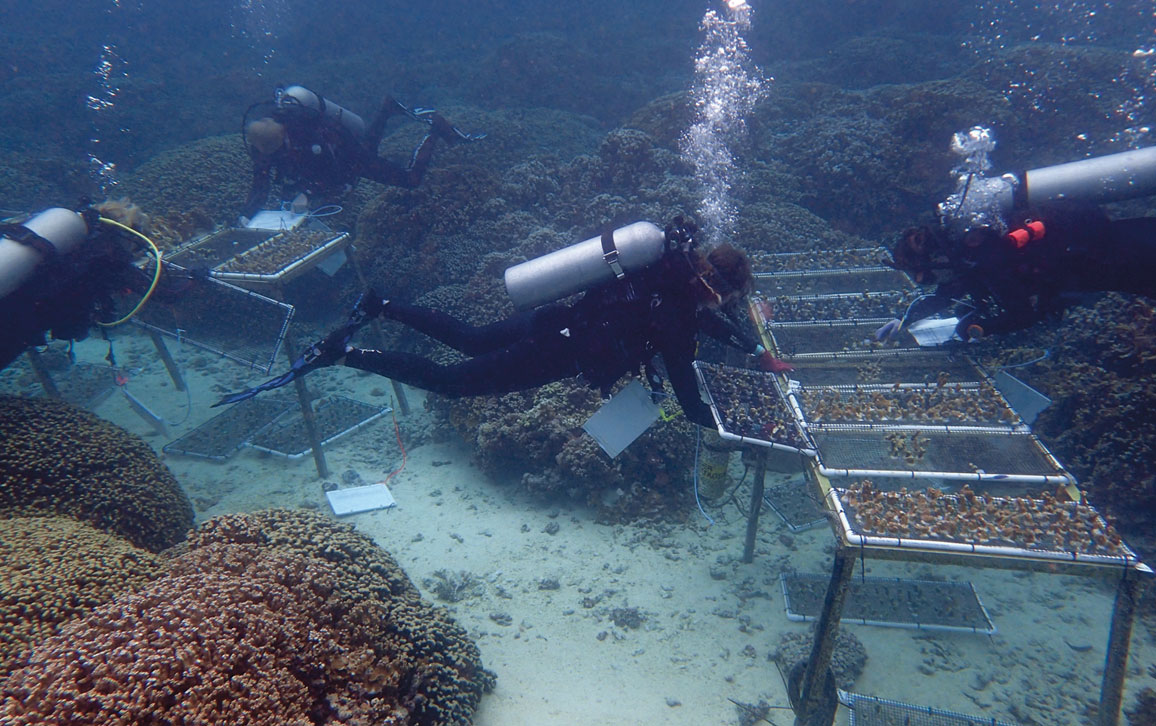
Shayle Matsuda
One of the leaders of the nascent Hawaiian Renaissance, Kenneth Brown, a descendant of Hawaiian kings, was a legislator in Hawaiʻi state government at the time, and a major supporter of the Hōkūleʻa voyages. He also wrote the famous Mālama Essay in 1973, which pointed out in an address to the Hawaiʻi State Legislature that intimate knowledge of and care for the environment was the foundation of traditional Hawaiian land use, and warned against the growing pressures of economic development trumping all other concerns. His essay became the foundation of the Mālama Hawaiʻi (Care for Hawaiʻi) movement, which has ensured that care for the land and its biocultural resources is a central part of the Hawaiian Renaissance.
The Renaissance extends into academia, with more Native Hawaiian PhDs emerging to contribute to the rapprochement of Western science with traditional approaches. This objective requires cogeneration of knowledge, acknowledgement of the merits of disparate worldviews, and focused efforts to wield the best of science, guided by island values and approaches proven over a millennium of island self-sufficiency. The Hawaiian Footprint Project of Gon and the research into indigenous resource management systems of Winter are examples of this emerging body of work.
The archipelago of Hawaiʻi was initially inhabited by an island people who embraced the value of native biodiversity, harnessed the productivity of nature, and enhanced existing ecosystem services. This Hawaiian model merits emulation around the world. Hawaiʻi also can be a model for merging two worldviews in a mutually beneficial way and for exploring the similarities between indigenous and Western approaches to science. In doing so, we can draw from the best of both worldviews to successfully navigate an uncertain future.
Principal among these mergings is the idea that more diverse systems are more resilient to disruption and change. This established concept in ecology parallels concepts from social-ecological systems in the precontact era that were resilient in the face of intense, unpredictable weather events. These systems can inform adaptive management in coastal communities that are facing the same uncertain future.
Native Hawaiian scientists often straddle both worlds, and cutting-edge research that draws upon each has shown that we have the ability to feed current population levels, even under the context of climate change. Ecologically appropriate forms of agriculture can provide not only food for people, but also habitat for native and even endangered species, providing a pathway for the latter’s recovery.
Both of us are faculty members in the Biocultural Initiative of the Pacific, a multidisciplinary effort at the University of Hawaiʻi to encourage biocultural research and approaches in Hawaiʻi and the Pacific. The Hawaiian biocultural approach forges a system of resource comanagement through melding the cultural and biological values of a place, listening to the voices of indigenous communities, honoring their choices, and encouraging their actions. This approach has already been embraced by the Hawaiʻi Conservation Alliance (a cooperative of 25 of the leading federal, state, and private conservation entities in Hawaiʻi). This group issued a position paper on the role of Hawaiian culture in conservation efforts in Hawaiʻi. All members ratified this position, which proclaimed in its preamble:
In Hawaiʻi, integration of Native Hawaiian approaches and knowledge systems with conventional conservation efforts is essential to achieve HCA’s vision of sustainable communities built upon a foundation of Hawaiian values, and actively perpetuating thriving lands and seas through active management and restoration.
Not only do we have more control over our destiny than the common dystopian narrative of climate change suggests, but also nature is proving to be more resilient than we imagined it could be—as demonstrated by research conducted at the Hawaiʻi Institute of Marine Biology in the largest barrier reef in Hawaiʻi, which is located in Kāneʻohe Bay. It’s already experiencing projected future ocean conditions in terms of water temperature and acidification, yet maintains the highest coral cover in Hawaiʻi. Emerging tools in genomics and evolutionary biology are being used to explore how these naturally occurring resilient corals can survive in a warm, acidic ocean. This knowledge could be used to engineer “super corals” and will eventually have global implications. Preserving diversity will be increasingly important in a fast-changing world.
Hawaiʻi can demonstrate in microcosm a more sustainable and resilient way to exist on our island planet. Precontact Hawaiʻi demonstrated that an expanding human population does not necessarily mean that biomes crucial to our survival, such as forests, shrink or even disappear. Hawaiʻi is an example of how ecosystems and large human populations can coexist, and of how cultural diversity and biological diversity not only can flourish together, but should be codependent. How can that express itself in our world today?
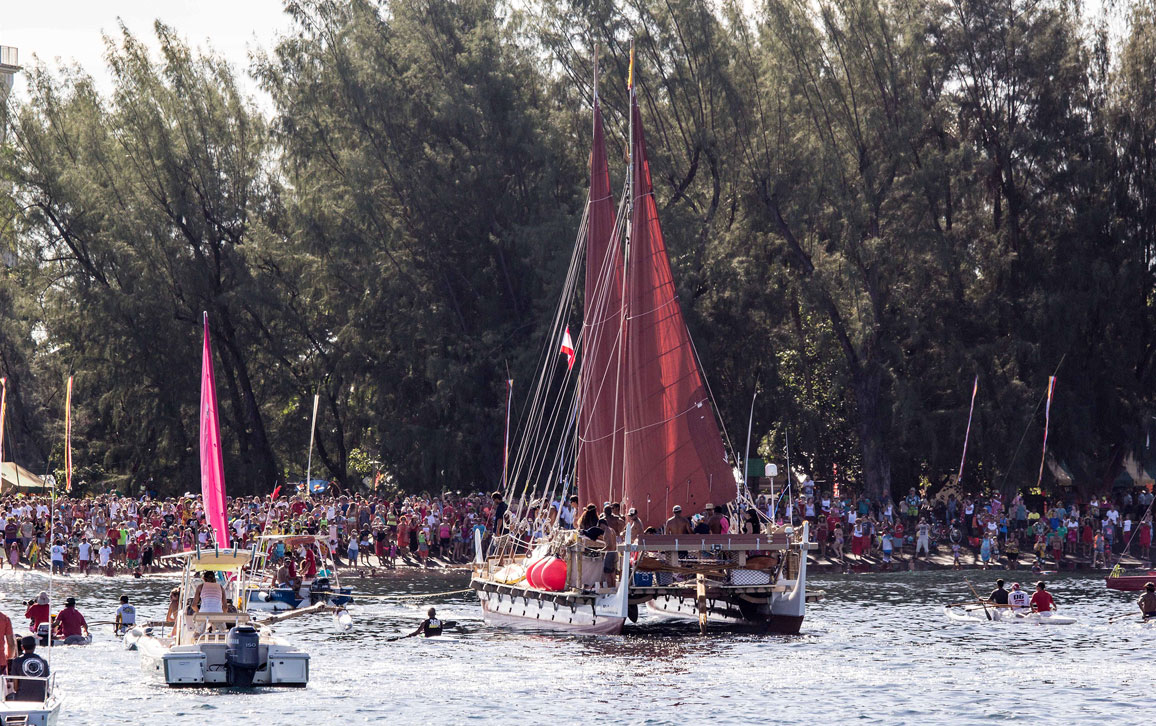
Polynesian Voyaging Society and ‘Oiwi.
In 2017 the Hawaiian voyaging canoe Hōkūleʻa, which ostensibly began the Hawaiian Renaissance, completed a three-year global circumnavigation using only traditional Hawaiian wayfinding, closing the circle on the idea that Hawaiians were expert oceanic navigators and long-distance voyagers. As she made her way through 150 ports, 23 countries and territories, and eight of UNESCO’S Marine World Heritage sites, the crew engaged with indigenous and local communities, exploring how to live sustainably. During the voyage, more than 245 participating crew members, including one of us (Gon), connected with more than 100,000 people throughout the world in communities across the Pacific, Tasman Sea, Indian Ocean, Atlantic, and the Caribbean, including Samoa, Aotearoa (New Zealand), Australia, Indonesia, Mauritius, South Africa, Brazil, U.S. Virgin Islands, Cuba, the East Coast of the United States, Canada, Panama, the Galápagos, and Rapanui.
Across that global realm we pulled together the common threads of the indigenous relationships among people and their lands and waters, finding the common idea that people and their places are inseparable and that the health of place is the health of its people. Moreover, we found that when there were long-standing relationships of that sort, spanning centuries or millennia, the biodiversity—the biocultural diversity—of those places is most intact. The United Nations Development Program (UNDP) agreed in a 2017 blog post:
There is a growing understanding that indigenous lands and waters represent 80 percent of the world’s biodiversity, that indigenous peoples are effective stewards of these areas, and that these ecologically intact areas of the Earth are a vital strategy for a sustainable future.
The task is ongoing, and the idea arises now that in the next phase of the Hawaiian Renaissance, a goal should be to demonstrate that Hawaiians were, and can again be, masterful ecologists, naturalists, landscape engineers, and resource managers. Surviving an era of conscious suppression, during which both Hawaiian ecosystems and Hawaiian culture were gravely damaged, we enter a phase of rebuilding, recovery, and reestablishment of the relationships that originally resulted in a millennium of sustainable coexistance of people and nature.
This idea was the underlying message when the International Union for the Conservation of Nature’s World Conservation Congress (IUCN’s WCC) was held in Hawaiʻi in 2016, and the message was heard clearly by 10,000 delegates from 192 countries. It was at that Congress that the IUCN ratified full voting membership for indigenous organizations and unanimously passed a resolution, sponsored by Gon, affirming the role of indigenous knowledge and approaches in conservation efforts. The IUCN leadership informed us that the 2016 Congress was the best attended and most successful in the history of the IUCN, and acknowledged that Hawaiʻi is at the forefront of biocultural approaches to conservation and offers a valid pathway for the world. The “Hawaiʻi Commitments,” a major policy outcome of the 2016 WCC, declared the need to create a global culture of conservation while pointing to Hawaiʻi as an example for our planet.
The United Nations (UN) followed suit in 2018 by designating Hawaiʻi as one of its regional 2030 Sustainability Hubs, the first Pacific and Island hub designated worldwide. The UN invitation recognizes the collaboration of public and private leaders in Hawaiʻi to develop culturally appropriate policy and strategies to achieve sustainability goals. The Hawaiʻi pathway has been laid out. But will that path be taken?
That depends on what humanity chooses in the decades to come. If we choose to live in a world where indigenous cultures not only survive but thrive, and their perspectives on resource management are honored and embraced, we can couple that with the best that Western science can offer, reestablish caring reciprocal relationships between people and nature, and remain hopeful for the future of our grandchildren’s grandchildren.
Click "American Scientist" to access home page
American Scientist Comments and Discussion
To discuss our articles or comment on them, please share them and tag American Scientist on social media platforms. Here are links to our profiles on Twitter, Facebook, and LinkedIn.
If we re-share your post, we will moderate comments/discussion following our comments policy.